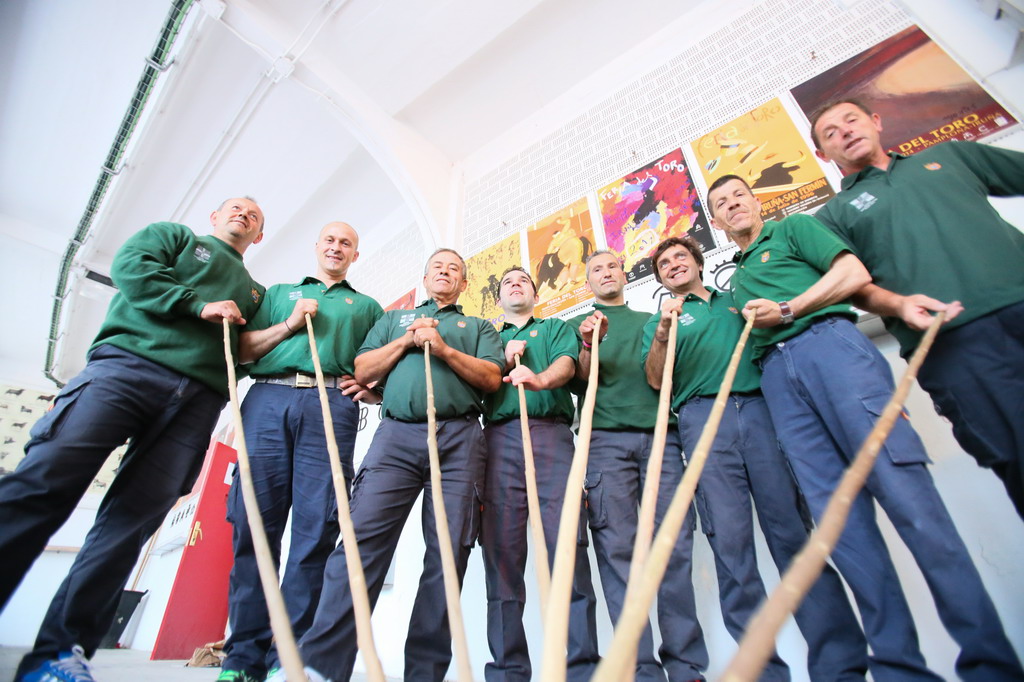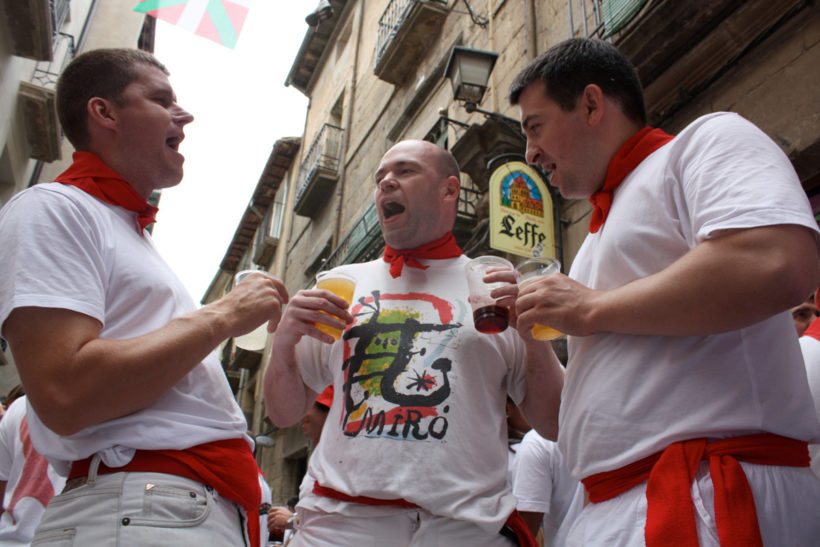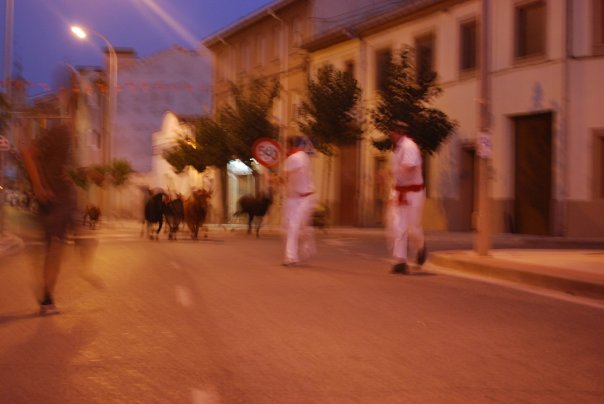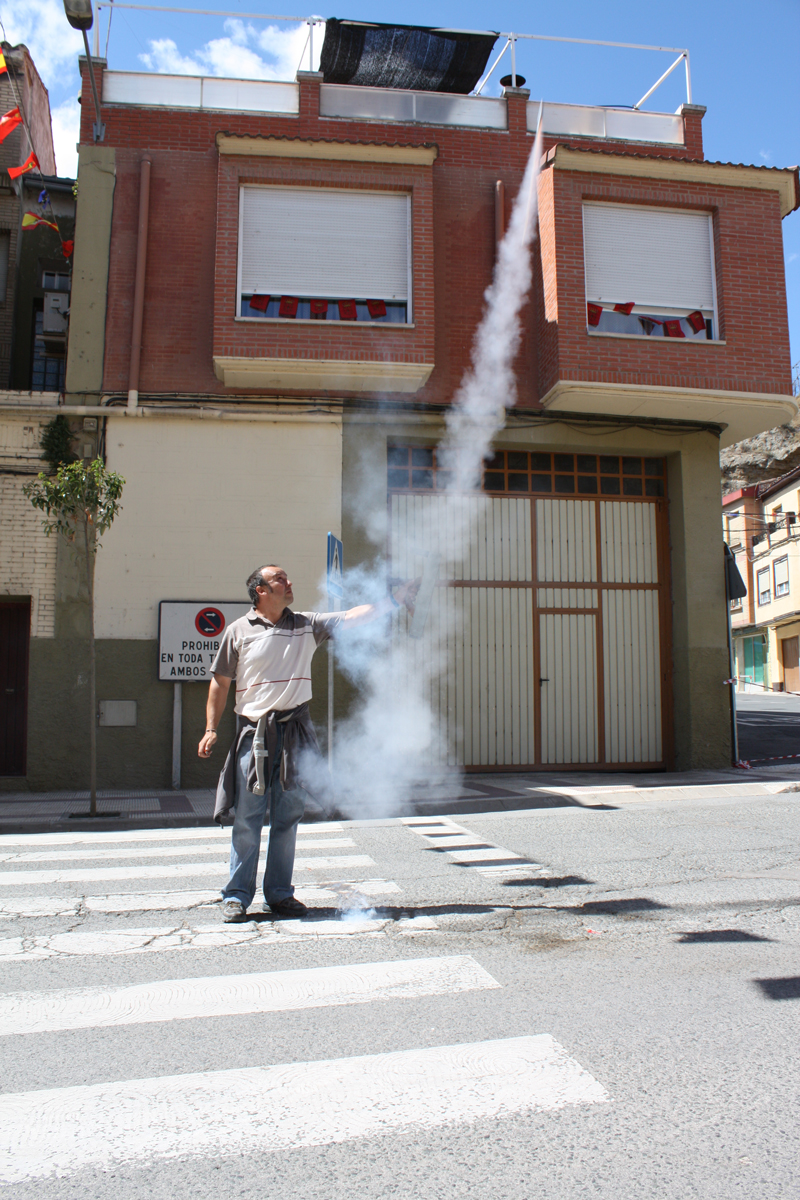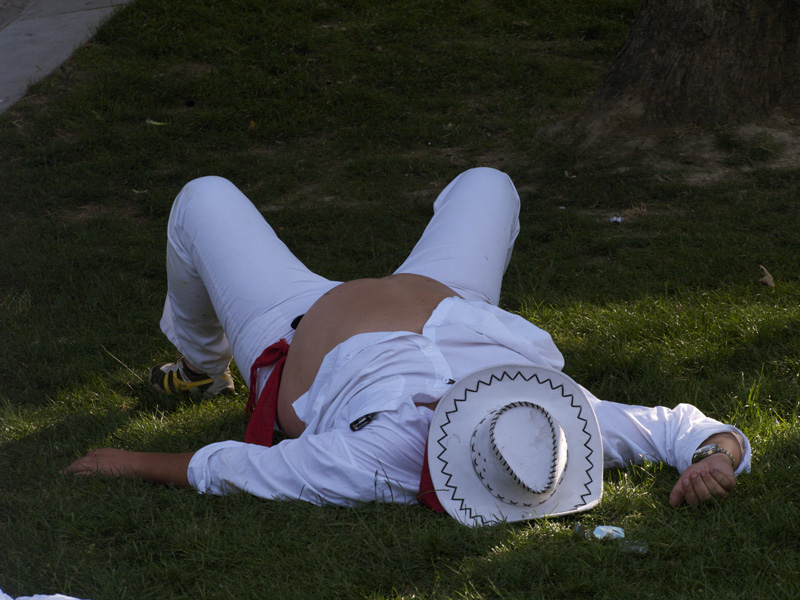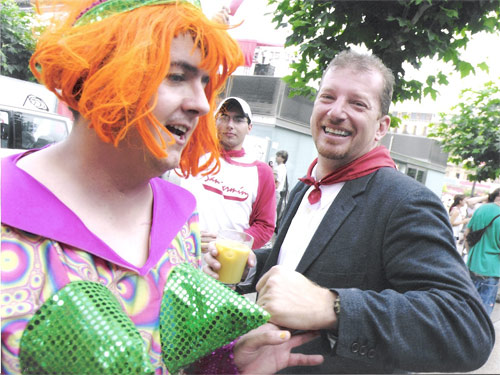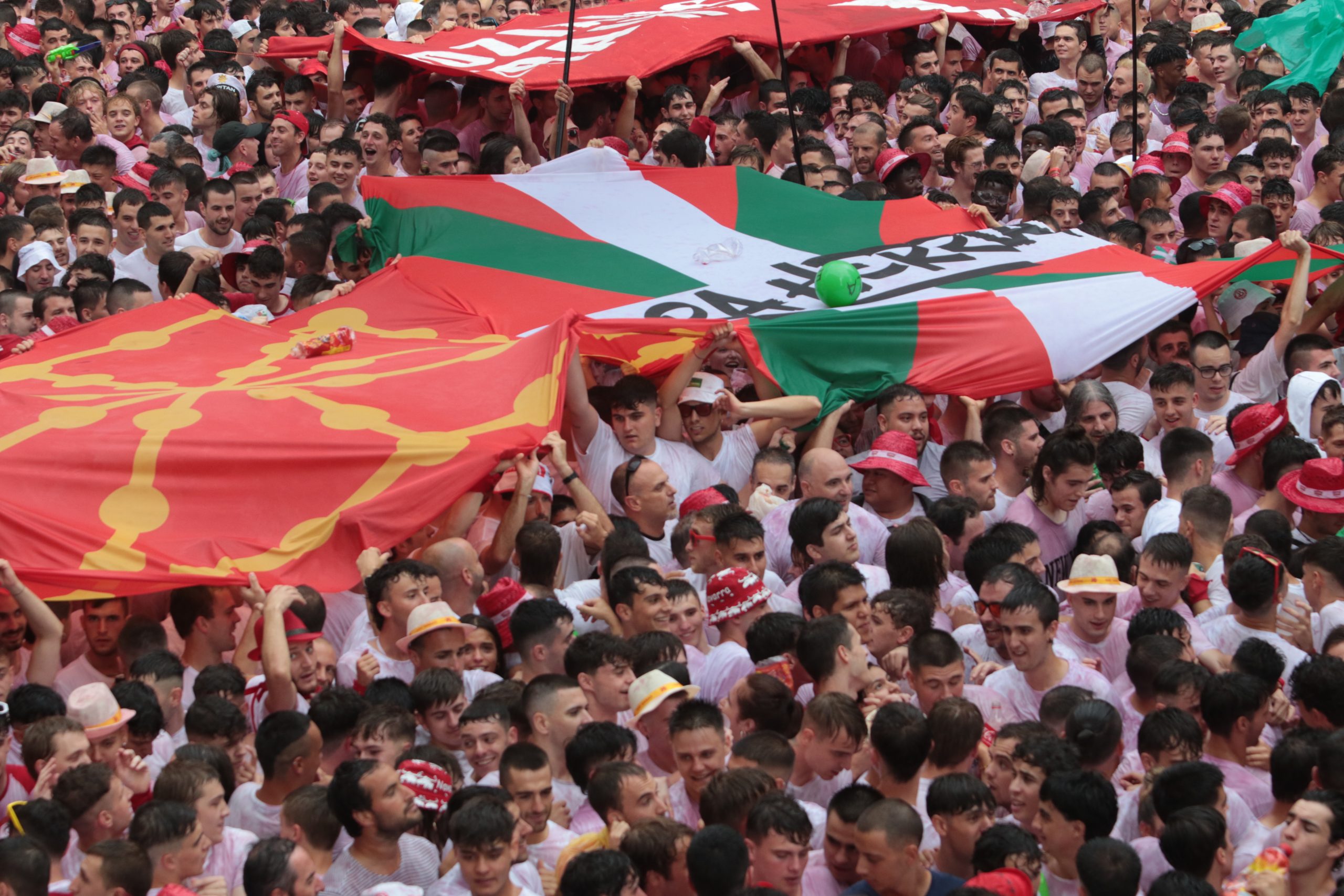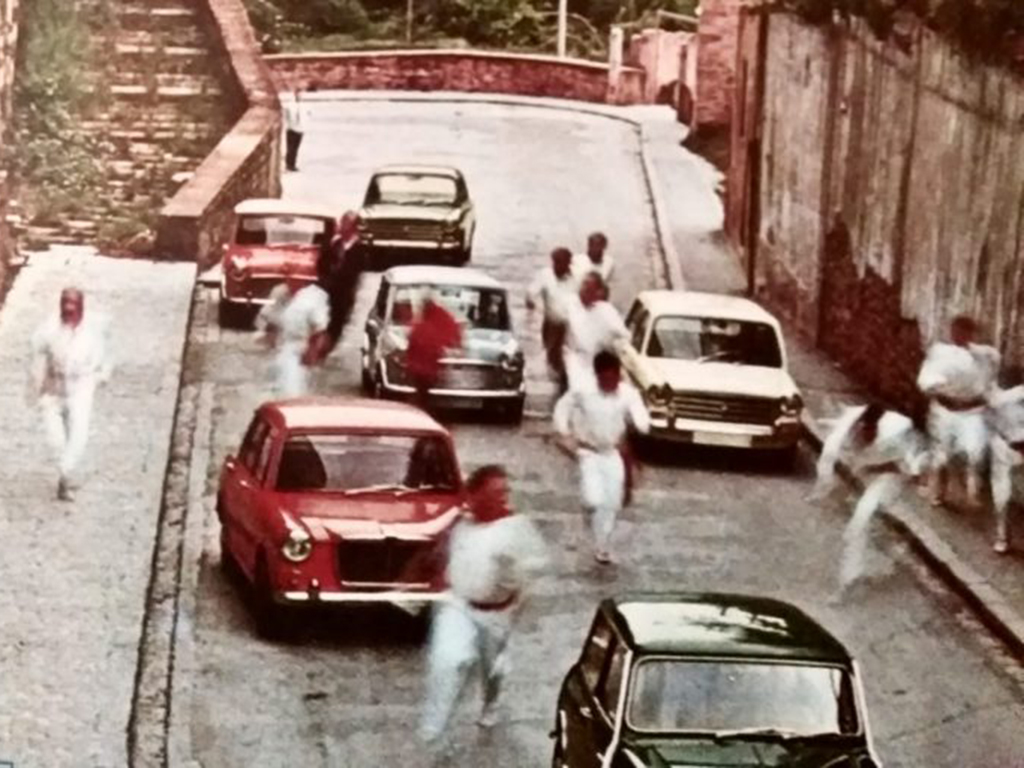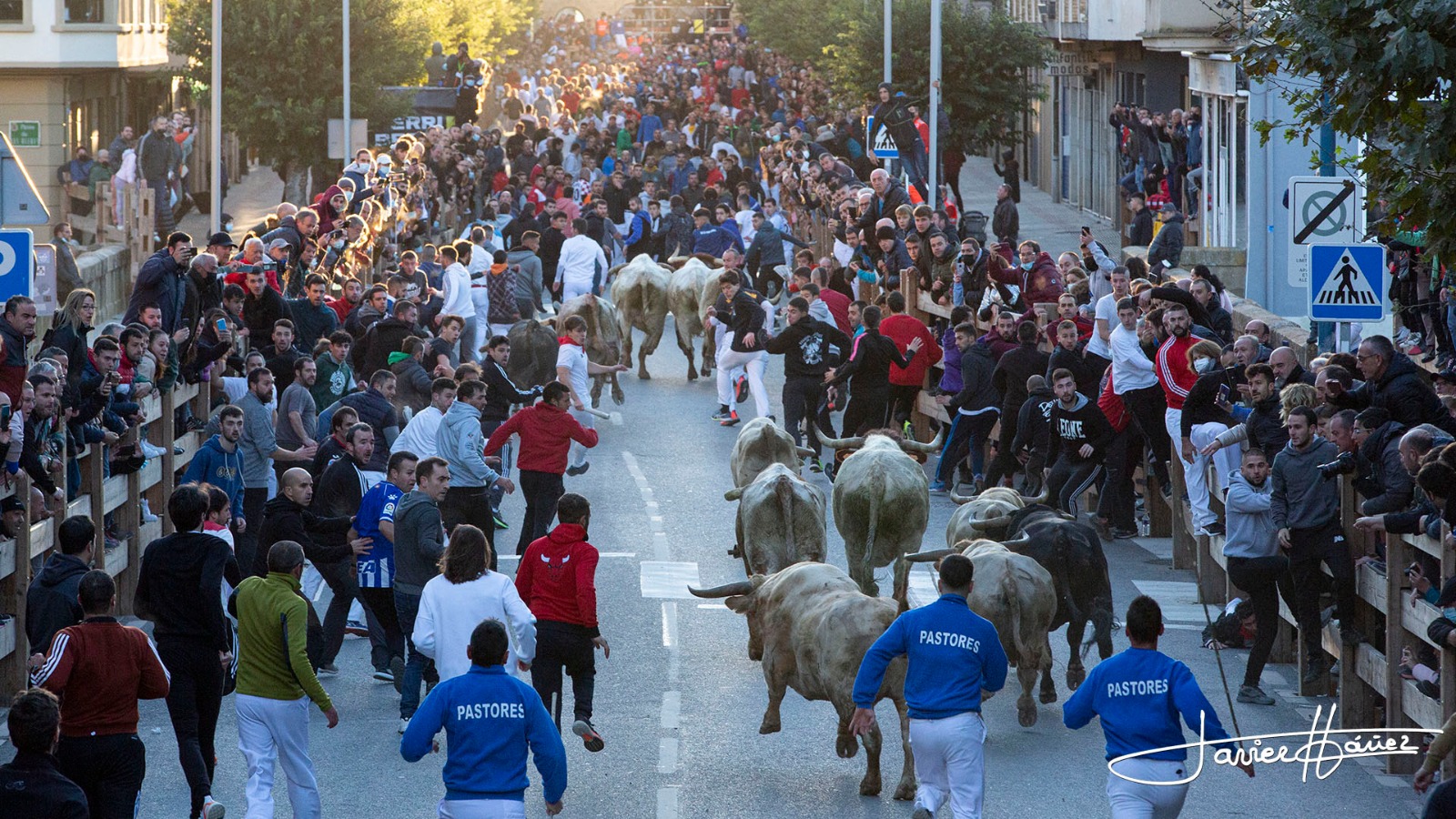Kategoria: Sanfermin Bloggers
Beyond the Walls, Alegría by Mat Dowsett
Pamplona. Home of the running of the bulls and the fiesta to end all fiestas. San Fermín draws a varied and international following, but very few foreign visitors are aware that Pamplona is only the tip of the iceberg when it comes to fiestas and bulls. Across Spain and beyond there are many hundreds of fiestas and thousands of encierros every year. Within the old walls of Pamplona a local drama is played out on an international stage, but beyond the walls are the unseen and untold tales of the people, the bulls and the streets of these other fiestas.
“Find ecstasy in life; the mere sense of living is joy enough.” Emily Dickinson.
A single and unifying element of the fiestas of Navarra is to be found in the interaction of people and streets when the txupinzo has taken place. The anticipation of those days of joy, the pent-up emotions and overwhelming sense of goodwill suddenly comes pouring out in a wave of happiness and mutual celebration. This is alegría.
Alegría is a simple and uncomplicated feeling that can be overwhelming or can actually be very childlike. Alegría is very personal, but some might compare it to a form of enlightenment; when the mind and body become at ease, at one with their environment and when all cares and concerns melt away into the trivial echoes of somewhere else.
On the streets of a Navarran town in fiestas the collective spirit, the unity and the humanity brought together is accompanied by music, dancing, food and drink. It is difficult in these times not to feel the sense of joy, very much like Christmas morning. This feeds the soul.
To celebrate is to live, and to celebrate with friends is to live many times over. When the feeling of alegría is shared then it becomes memorable.
Here, in the photograph, is a personal moment of alegría. This is the Navarran city of Tafalla less than an hour after the txupinazo on the 14th August in a year not too long ago. The scene is very familiar as friends, in the spirit of the moment, sing along with each other with shared happiness and in the knowledge that the fiesta is stretching out in front of them like a lush, green plain.
This is our fiesta, our alegría.
Más allá de las paredes – Ego, por Mat Dowsett
“The strongest poison ever known came from Caesar’s laurel crown.” William Blake.
“When someone sings his own praises, he always gets the tune too high.” Mary H Waldrip.
“I don’t believe in elitism, I don’t think the audience is this dumb person lower than me. I am the audience.” Quentin Tarantino.
Every year during San Fermín it seems that one particular toy, trinket or gadget is more popular than the rest. They become fashionable and take off like no others. A few years ago this ‘honour’ went to the loud-hailers (or megaphones) that became so irritating they were eventually banned.
These loudhailers were unique. What they did was quite remarkable as they allowed the individual to lift their voice above the rest of the crowd; to be heard, to be able to express themselves. It was truly liberating…in theory. In truth the outcome was that everybody had a lot to say and none of it was worth listening to.
The modern technological world of data, social media and smartphones has allowed our voices to be heard on a wider scale and to a greater audience. A runner can tweet his last thoughts at 07:59, record his bull-running experience on a Go-Pro, then upload the video via YouTube and Facebook to a global audience by 08:05.
Suddenly our society seems to demand that we become stars of our own reality show. Suddenly we all need to be heroes, we all need to be famous, we all need to be known. The encierros have fallen victim to this same narcissism such that everybody wants to write a book about their encierros, be in their own film and to become part of the encierro cult of celebrity.
Whatever happened to running for the sheer hell of it? Didn’t Helen Keller say “Life is either a daring adventure, or nothing”?
Nietzsche would sympathise. As human beings we yearn for meaning. Our existential minds function on a risk/reward balance and so if a runner takes the risk he damn well wants the reward in return. He wants recognition. He wants affirmation and he wants to be admired by all his peers. This is natural and understandable but should runners embrace this or even heavily promote it, or should they minimise it and step away from it in favour of something more humble, something more personally intimate and, at the end of the day, something more enlightened?
What many runners forget is that the encierro is not a competition. There are no trophies, awards, points, leagues or championships. To attribute some kind of classification or hierarchy becomes both arbitrary and artificial. Remember that a first-time runner with no experience has just as much right to be on the streets as a seasoned runner of many years. As long as they follow the rules they take their own chances and the true contest is with themselves and themselves alone. Instead the running community has evolved and has made the mistake of turning people it admires into heroes and heroes into gods.
Now runners aspire to a number of things; to be part of a perceived ‘elite’, to run without a break for decades, to get that perfect photograph of the perfect run, to be in the newspapers or pinpointed on TV and be called out as a great runner. All of these things are a part of the process of moving away from the encierro as being personal and individual. Instead this is a move to a different set of egotistical motives where the encierro itself becomes secondary to the celebrity that comes with it.
When we deify people they become infallible and we close our minds to the reality of the world around us and them. We then aspire to be like these people but do so with these closed minds. It is an illusion and one that leads us down a road towards the celebration of ego and not the celebration of the soul. It is not alegría.
Similarly, when we choose to declare ourselves to be members of an elite, when we make our films and write our books then we are arrogantly claiming to represent something which we do not own and which we were not chosen to speak for. We should consider with great care the implications of standing up and shouting about it through our loud-hailers. We should be careful about what we claim to be. There are plenty of other voices that are much quieter but may be more knowledgeable and may hold a contradictory view to our own. We cannot claim to speak for everyone, and we cannot declare ourselves to be great.
As George RR Martin wrote; “Any man who must say ‘I am the King!’ is no true king.”
While I appear to be condemning, I am also appreciative of this encierro world. Pamplona’s encierro is truly remarkable. Yet, if I could go back in time I would do things differently with the hindsight of experience. I made my own mistakes, not least spending far too much time trying to be recognised as a runner and not enough time simply enjoying myself. If I rewound the 10 years on the streets of Pamplona I would not have worn the blue shirt that I hoped would help me stand out in photos, and my own book would have turned out very differently with a greater emphasis on the encierro history and without the inclusion of the focus on individual runners or my own self-indulgent opinion. I learned to view encierros differently thanks to travelling wider than Pamplona. This was no overnight revelation, but a gradual transition and I realised that when I stopped worrying about getting a good photo, stopped worrying about having a perfect run then I started to enjoy the encierros much more than I ever had.
I recall running one morning in Tafalla down towards the Plaza de Toros. Three of the toros had strung out in a line. I was just behind another runner I knew and just in front of a pastore. The uninterrupted view of the toros that came gliding past us just inches away, was spectacular and memorable. My fellow runner and I embraced at the end of the run in mutual recognition of a wonderful experience of being so close to these animals in full flight and to be able to drift away and watch them vanish through the main gate. Then it was over and we went our separate ways. I have no photograph of that encierro, There was no TV coverage, it did not make the newspapers. Nobody congratulated my running and nobody cared except for my friend who shared it with me. But what I have and always will have is the knowledge that I ran with pure joy in my heart and with no other motive.
Let’s be honest, no regular runner follows the same mental course from very first run to very last. When we first step out into the streets we simply want to try it out, to survive and come home safe. As we run more we may choose to try to perfect a certain stretch, to push ourselves closer and closer or we may choose to hold a certain point time after time. Later on in life we may abandon the idea of running well in favour of simply wanting to be out there to enjoy the atmosphere and get a glimpse of the toros. We each make our own choices in the encierro and as such our attitudes and behaviours are then open to being praised or criticised, and in a very Kiplingesque way we should be able to deal with both outcomes equally. Our own choices dictate whether or not we are the type to seek out the encierro celebrity or to shun it. In the end, neither are wrong, but my argument is that a runner can be acting within the rules but outside of the “spirit of the encierro”. My personal belief is that certain attitudes and motives are not truly within the spirit of the encierro even if they are perfectly within the rules. However, no single person makes this call; we do not own the fiesta, we do not own the encierro.
Adding layers of additional complexity to the world that surrounds our encierros detracts from the true heart of the event. We should always go back to that datum which is the fundamental foundation of why we are there; streets and animals. All of the additional celebrity is a complication that distracts us from what it is that joins us, drives us. As I am fond of saying to some of my friends, and heavily paraphrased from the famous British rock climber Ron Fawcett:
“Walk out onto the course of your favourite encierro. Stand in the middle of the street and trace the line of the run going away from you. There, you’re home.”
You may surprised to learn that you don’t need to make a loud noise to be a success. Some of the quietest people are those having the most fun, and some of the best encierro runners are people we don’t know, and will never know.
Run as you will, but if you can then reach into your heart and run because of the joy that sits there, and “not for the sake of a ribboned coat, or the selfish hope of a season’s fame” as Sir Henry Newbolt put it. Put the Go-Pro away, turn your smartphone off and then run for yourself and run for fun. Or more simply; run as you wish to run, but put the loud-hailer down.
Cohete, by Matthew Dowsett
Pamplona. Home of the running of the bulls and the fiesta to end all fiestas. San Fermín draws a varied and international following, but very few foreign visitors are aware that Pamplona is only the tip of the iceberg when it comes to fiestas and bulls. Across Spain and beyond there are many hundreds of fiestas and thousands of encierros every year. Within the old walls of Pamplona a local drama is played out on an international stage, but beyond the walls are the unseen and untold tales of the people, the bulls and the streets of these other fiestas.
At 8am and in those moments afterwards, you may hear a distant explosion as a rocket known as a cohete reaches up into the sky and leaves a puff of white smoke. The sound tells you that the encierro has started/stopped. It is very rare to see the rocket, it is an anonymous punctuation in the morning – a sign from the gods that the die is cast and the bulls that haunt our dreams have been released.
Elsewhere the cohete is much more visible. Seen in this picture from Funes in Navarra. The cohete is everywhere, and is a crucial part of the encierros. Without the cohete the people may not know that it is time to close their doors, put up their shutters, lock their shops and send their customers on their way for a short time. Without the cohete the group of young people gathered around the bar may not know that a horned animal will be running down the street at any moment. In Fune, for example, this is very serious – on some mornings the streets are so quiet that a vaca or torico can run a lonely line up deserted streets and only meet a person after a hundred metres of emptiness.
The cohete is one of the vehicles whereby the encierros are efficiently run, and they are used widely, though not uniformly. Not every cohete is fired from the hand as in the photograph, and with good reason. One evening in Valtierra we had finished our run, the manada was back in the corrales and the jefe attached a cohete to the barriers and lit it with his cigar. We stood a few metres away awaiting the whoosh and the arcing smoke before the final explosion that would open the gates and send us into the evening to enjoy a fine meal somewhere and talk about the encierros of the day. Instead the cohete remained on the barriers and exploded with an enormous boom that made our ears ring and brought derisory comments from the nearby balconies.
The next day we stood a little further away, and a good thing too as the cohete exploded again. Once bitten, twice shy.
In The Shadow Of The Dark Moon, by Katxi
In The Shadow Of The Dark Moon
24/07/2008. By Katxi
An endless flow of sentimental and romantic words have streamed across the pages of books and via the internet on the subject of San Fermin and the Running of the Bulls. The love for this fiesta is almost universal, and yet all is not well and under the surface lies a darkness that takes many forms. Over the coming months a series of articles by invited writers will explore this dark side.
To contribute or comment please contact Katxi at katxi@email.com
Introducing, by Katxi
ntroducing
01/02/2007. By Katxi
This month I would like you to read an article by a guest writer: Rick Musica. Rick is from Chicago, he lives by the beach in Fort Lauderdale, Florida. Rick is a Flight Attendant for American Airlines, and at 40 years old Musica is still single, (he claims that no woman will put up with his love of all things Pamplona).
Rick is happy to talk about what makes him tick and would like to share this article with you, after which he’d love to have you buy him a beer, so look him up!
Fiesta
For many people, running a marathon may bring complete jubilation, while for others it’s exhausting just thinking about it. Trekking across the Himalayas may be blissful and serene to one person and completely insane to the next.
No matter what the event, if it is something that inspires, intrigues, or makes you “tick,” you just do it. And then there is the Running of the Bulls! Some things just defy logic. And for nine days in July, most logic is left on the outskirts of a town called Pamplona. When you mention Pamplona to the casual observer, many could not find it on a map, but you mention the Running of the Bulls, and quickly, everyone knows exactly where Pamplona is! But how many of the 2 million plus visitors every year really get to experience fiesta?
Millions of tourists flock to Pamplona every year to check off “Running with the Bulls” on their list of life’s events not to be missed. Sadly, many never venture past the madness of Plaza Castillo. There is so much to Fiesta that it is virtually impossible to see everything that this party has to offer.
And that is the beauty of Fiesta! Let’s face it, most people come to Pamplona the first time to say they “Ran with the Bulls”. Maybe it was Hemingway who brought it to their attention. Maybe it just really is the greatest place on the planet! But whatever the reason, they come. Some never leave; ever! What makes people come year after year after year? It’s very simple. Many people would say the Bulls. And that is a very good answer. But to many of the people who have been coming for years, (10, 20, 30 40, 50+), it’s the people.
Many of the “foreigners,” myself included, came that first time for the Bulls(that story is for another time), but many return, year after year, for the people! The hospitality and friendliness of the residents, and to a major degree, the visitors, is extremely unique! Fiesta may be only nine days long, but the friendships last a lifetime! Fiesta is the ultimate gift.
It is always giving. No matter what you’re looking for, at some point during the week, Fiesta delivers! But what you take from it, depends on what you give to it! If you are lucky enough to be from Pamplona, this love of Fiesta starts at a very early age, like birth! Despite the “vast” amount of adult beverages, (alcohol) available and the outrageous percentage who take full advantage of that availability, Fiesta is still very much about the kids(and those of us who never grew up).
Running with the Bulls makes many people “tick.” Dancing until sunrise in Plaza Castillo makes many people “tick” Partying up and down San Nicolas all night makes many people “tick.” Closing down the Savoy every night, that makes me “tick!”
So what are you waiting for? What makes you “tick?”

